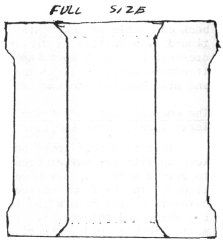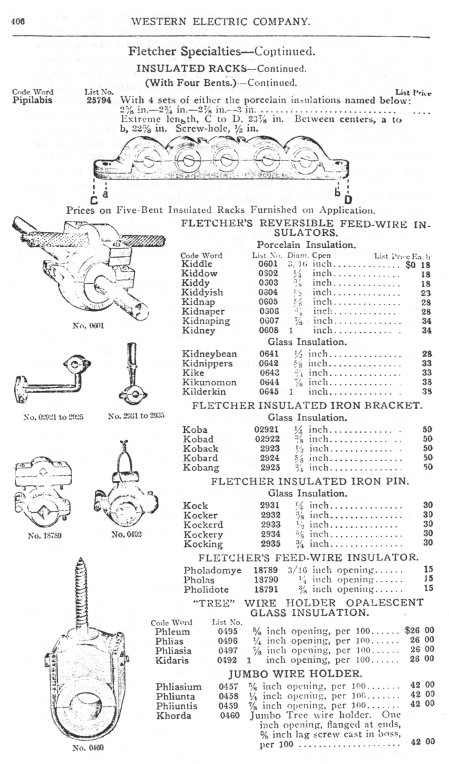Rack Wire Holders
Reprinted from "INSULATORS - Crown Jewels of the Wire", February 1974, page 4
QUESTIONS ANSWERED BY N. R. WOODWARD
Author of The Glass Insulator in America and originator of C. D. #'s
(Consolidated Design Numbers)
Paul Greaves writes: I have a few insulators that I have not been able to
identify any place, and I would appreciate any information you might have.
The
first is a glass split knob (drawing at right). It is aqua colored and looks
much like Hemingray glass. Mine was dug up in the Sierras.


The second is a
CD-102 Brookfield with drip points (front-BROOKFIELD, dome-  ). The color is deep,
deep olive green with amber swirls, almost black glass. I have not seen this
color any place else. Another is a CD-287 Locke (front- F.M. LACKE VICTOR N.Y.
PATD MAY 22, 1894 back- No 15 dome-
). The color is deep,
deep olive green with amber swirls, almost black glass. I have not seen this
color any place else. Another is a CD-287 Locke (front- F.M. LACKE VICTOR N.Y.
PATD MAY 22, 1894 back- No 15 dome-  ), aqua. Note the "LACKE" error.
Are mistakes rare in Locke insulators?
), aqua. Note the "LACKE" error.
Are mistakes rare in Locke insulators?
Also, I have a CD-191 (front-A.T.&.T.Co.
- small 3/16" high embossing), mold line over dome, old looking aqua glass
(swirls and bubbles). This was dug, also. If anyone has a bottom half, I need
this!
Finally, I have a CD-102 star which is only 3-3/16" high and 2-1/8"
wide (front-  dome- 3), color - aqua. This is the smallest glass insulator I
know of made for standard peg. Also, is the mold number rare on star insulators?
dome- 3), color - aqua. This is the smallest glass insulator I
know of made for standard peg. Also, is the mold number rare on star insulators?
If you would jot down on a piece of paper the approximate age, value and
rarity of these, I would greatly appreciate it.
P.S. Did Brookfield make the no name cable and Columbia insulators? Who made
the Manhattan?
- - - - - - - - - -
In reply to Paul Greaves: The two halves that you have found are in all
probability the insulating parts of some type of wire holder, used in the early
1900's. Enclosed is a page (following) from the 1904 Western Electric Catalog
that illustrates some of these. Since you state it was found in the mountains,
could have been from a "Tree Wire Holder" similar to the one shown.

Large Image (217K)
The Brookfield insulators with very dark glass were made mostly at the Old
Bridge Works, during the period around 1905 to 1915. They were not made
intentionally in these colors, but are the result of much cullet used during
those years. A concentration of very dark green or amber bottles would produce
dark insulators, varying with the material that happened to be used at the
moment. Sometimes one will find a Brookfield of that period that is a pure amber
color, with no green whatever. Most of them vary from a dark green to a
green-amber mixture. Probably all styles in regular production during those
years can be found in the dark colors. They are not rare, but seem to be quite
desirable to collectors. The backward 17 on the crown is a shop number, which
served to identify the items as to their source when they came out of the
annealing lehrs, ready for packaging.
I'm not familiar with the "LACKE" error, and would say it is not
common and might be of interest to "error" collectors. There are quite
a few Locke insulators with errors in the patent dates they carry.
The small CD #102 Star that you describe is one of a set of three, with shop
numbers 1, 2 or 3 on the crown; and usually or always the dot beside the star.
As you say, these are probably the smallest American insulators made to fit the
one-inch pin. There is an "S.F." that is about the same size. I know
of no other Stars that have a number on the crown. These little numbered Stars
also can be found with drip points.
Yes, Brookfield made Columbia and Cable insulators without the manufacturer's
name. As a matter of fact, very few of the Brookfield insulators with a saddle
groove are marked with the Brookfield name. Exactly why this is so is only
conjecture at this time. However, not all such "no-name" insulators
should be attributed to Brookfield, as there are others.
The Manhattan insulators are listed as a part of the Knowles line; and it is
entirely likely that at least a part of them were made for Knowles at the
Novelty Glass Company plant at Elmer, New Jersey. However, such things are very
difficult or impossible to establish firmly at this time.
| 